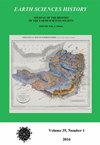THE FIRST NORTH CAROLINA GEOLOGICAL MAPS: DENISON OLMSTED AND ELISHA MITCHELL, 1821–1842
IF 0.3
4区 哲学
Q4 GEOSCIENCES, MULTIDISCIPLINARY
引用次数: 0
Abstract
The first state-sponsored geological maps for North Carolina were produced by Denison Olmsted and Elisha Mitchell and reflect the development of geologic thought, as well as the practical applications to which geology was being applied, at the beginning of the 19th century in the eastern United States. Despite Merrill’s (1964) dismissal of their mapping and descriptions as too general and of a reconnaissance approach, all studies of nature must have a starting point. Prior to the underfunded geological survey of North Carolina, the evaluation and location of natural resources in the eastern United States was spotty and often never reported. Although only the Mitchell (1829a) county-scale geological map of the gold regions of the North Carolina Piedmont garnered widespread dissemination as a result of the publicity surrounding the gold ‘boom’ in the region, the publication of the Olmsted (1825a, 1827) and Mitchell (1828a, 1829b) geological survey reports provided publicly available details and descriptions. Mitchell continued as a behind-the-scenes advocate for geological investigations in North Carolina even after the closing of the North Carolina geological survey in 1827. His travels, investigations, and observations culminated in his 1842 textbook and its accompanying geological map. Although this geological map still continued to use modified Wernerian stratigraphic terminology, the descriptive text on the units and their interrelationships indicated a continuing evolution of thought on the geological history of the state. The 1842 map continued to be used until at least 1877, when W. C. Kerr (1827–1885) and the 3rd North Carolina Geological Survey undertook a more detailed and comprehensive investigation (and mapping) of the geological framework of North Carolina (Holmes 1887). Thus, two men from very different backgrounds (both Yale, AB, 1813) and interests, and mainly self-taught in the geological sciences, provided the first steps in the description and mapping of North Carolina’s natural resources. Compared to the accomplishments of the later geological surveys, their work was limited in scope and detail. But, for North Carolina geology, and that of the southeastern United States, they were the forerunners in the field.第一张北卡罗来纳州地质图:丹尼森·奥姆斯特德和伊莱莎·米切尔,1821–1842
Denison Olmsted和Elisha Mitchell制作了北卡罗来纳州第一张由国家赞助的地质图,反映了19世纪初美国东部地质思想的发展以及地质学的实际应用。尽管Merrill(1964)认为他们的测绘和描述过于笼统,而且是一种侦察方法,但所有对自然的研究都必须有一个起点。在对北卡罗来纳州进行资金不足的地质调查之前,对美国东部自然资源的评估和定位参差不齐,而且往往从未报告。尽管由于该地区黄金“繁荣”的宣传,只有米切尔(1829a)县级的北卡罗来纳州皮埃蒙特黄金区域地质图获得了广泛的传播,但奥姆斯特德(1825a、1827)和米切尔(1828a、1829b)地质调查报告的出版提供了公开的详细信息和描述。即使在1827年北卡罗来纳州地质调查结束后,米切尔仍然是北卡罗来纳州地质学调查的幕后倡导者。他的旅行、调查和观察在1842年的教科书及其附带的地质图中达到了顶峰。尽管这张地质图仍然继续使用改良的韦纳学派地层术语,但关于这些单元及其相互关系的描述性文本表明,该州地质史的思想在不断演变。1842年的地图至少一直使用到1877年,当时W.C.Kerr(1827–1885)和第三届北卡罗来纳州地质调查局对北卡罗来纳州的地质框架进行了更详细和全面的调查(和测绘)(Holmes 1887)。因此,两位背景和兴趣截然不同的人(均为耶鲁大学,AB,1813),主要是在地质科学领域自学成才,为北卡罗来纳州自然资源的描述和测绘迈出了第一步。与后来的地质调查相比,他们的工作范围和细节都有限。但是,对于北卡罗来纳州和美国东南部的地质学来说,他们是该领域的先驱。
本文章由计算机程序翻译,如有差异,请以英文原文为准。
求助全文
约1分钟内获得全文
求助全文
来源期刊

Earth Sciences History
GEOSCIENCES, MULTIDISCIPLINARY-HISTORY & PHILOSOPHY OF SCIENCE
CiteScore
1.00
自引率
0.00%
发文量
1
审稿时长
>12 weeks
期刊介绍:
Earth Sciences History promotes and publishes historical work on all areas of the earth sciences – including geology, geography, geophysics, oceanography, paleontology, meteorology, and climatology.
The journal honors and encourages a variety of approaches to historical study: biography, history of ideas, social history, and histories of institutions, organizations, and techniques.
Articles are peer reviewed.
 求助内容:
求助内容: 应助结果提醒方式:
应助结果提醒方式:


